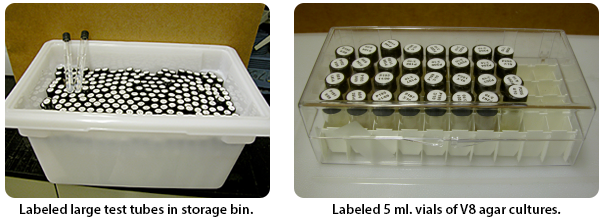It is extremely important to eliminate all bacteria from Pythium cultures to be put into storage. Commonly, Pythium isolates die relatively quickly if bacteria are associated with them in storage. In most media, Pythium cultures look slimy if bacteria are present. Pythium isolates grown on lima bean agar smell badly and look slimy if bacteria are present.
If bacterial growth is detected in association with Pythium (slimy growth on most media and slimy growth + foul smell on lima bean agar LB), transfer some hyphae back to water agar, one of the selective media or to water agar + rose bengal (0.08g of rose bengal in 500 ml of water agar; see Part 1: Media for Pythium Culture). After a few days, transfer back to PDA or LB to verify that bacteria are no longer present.
Another trick: Make the Pythium grow up through water agar. Then take hyphal tips where they emerge. To do this, slit across the diameter of a water agar plate with a sterile scalpel. Lift part of the agar from the plate and slip a bit of the contaminated culture under that agar flap. Incubate the plate until the Pythium is near the surface of the new agar and transfer hyphae from there.
Once a clean culture is obtained, transfer it to any agar that will support Pythium growth.
Sterile Water Storage
Transfer a well growing culture to water agar. Once the water agar is colonized, cut the colonized water agar into cubes and suspend 5-10 in autoclaved, sterile tap water in a 15 ml test tube (NOT distilled water and NOT in smaller tubes). Label the tubes with the isolate designation and the month/year. Tighten the caps well and store the tubes at room temperature (NOT in the refrigerator). It is wise to seal the caps with parafilm so that they do not dry out. Sterile distilled water or storage in a refrigerator reduces the duration of viability. Depending upon the isolate and whether bacteria are absent, Pythium may remain viable in water storage for 3-4 years, sometimes longer. Some isolates die quickly anyway. Most isolates die quickly or are very difficult to recover if bacteria are present.


It is best to have at least 2 tubes per isolate in at least 2 different storage methods.
2, 5 ml vials of V8.
2, test tubes of water agar blocks in tap water.
2, test tubes of Pythium on sunflower seeds in tap water.
Sterile Seed Storage
Place 2-4, unsalted, non-roasted, hulled sunflower seeds in a 10-15 ml test tube of tap water and autoclave. Or if you can get them, place 2-4 hemp seeds in tap water and autoclave. (Seed of fiber hemp really ought to be legal to buy in the U.S. but is not in 2014!!)
Sometimes it appears that the autoclaved tubes are contaminated because a film or scum is seen on the water surface. That is usually not contamination. Rather, it is oil extracted from the seed during the autoclaving. (Plate a loop-full to verify for yourself that it is not contamination.)
Place a bit of Pythium-colonized agar in a seed/water tube.
Be certain some growth begins in the tube in a day or two.
Tighten the tube cap very well. You may want to parafilm-seal tubes to be certain they do not dry.
Store the tubes at room temperature. Seed/water-stored isolates may survive 5-6 years or longer without transfer, depending on the isolate.


